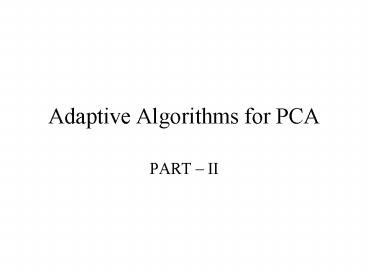Adaptive Algorithms for PCA - PowerPoint PPT Presentation
1 / 11
Title:
Adaptive Algorithms for PCA
Description:
Feedforward weights W are trained using Oja's rule. ... It should be noted that when convergence is reached, all the lateral weights must go to zero! ... – PowerPoint PPT presentation
Number of Views:28
Avg rating:3.0/5.0
Title: Adaptive Algorithms for PCA
1
Adaptive Algorithms for PCA
- PART II
2
- Ojas rule is the basic learning rule for PCA and
extracts the first principal component - Deflation procedure can be used to estimate the
minor eigencomponents - Sangers rule does an on-line deflation and uses
Ojas rule to estimate the eigencomponents - Problems with Sangers rule-
- Strictly speaking, Sangers rule is non-local and
makes it a little harder for VLSI implementation.
- Non-local rules are termed as biologically
non-plausible! (As engineers, we dont care very
much about this) - Sangers rule converges slowly. We will see later
that many algorithms for PCA converge slowly.
3
Other Adaptive structures for PCA The first step
would be to change the architecture of the
network so that the update rules become local.
INPUT X(n)
LATERAL WEIGHTS - C
WEIGHTS -W
4
This is the Rubner-Tavan Model. Output vector y
is given by
x1
w1
y1
c
x2
y2
w2
- C is a lower triangular matrix and this is
usually called as the lateral weight matrix or
the lateral inhibitor matrix. - Feedforward weights W are trained using Ojas
rule. - Lateral weights are trained using anti-Hebbian
rule.
5
- Why this works?
- Fact We know that the eigenvectors are all
orthonormal vectors. Hence the outputs of the
network are all uncorrelated. Since, anti-Hebbian
learning decorrelates signals, we can use this
for training the lateral network. - Most important contributions of Rubner-Tavan
Model - Local update rules and hence biologically
plausible - Introduction of the lateral network for
estimating minor components instead of using
deflation
6
- However, the Rubner-Tavan model is slow to
converge. - APEX (Adaptive Principal Component Extraction)
network slightly improves the speed of
convergence of the Rubner-Tavan method. - APEX uses exactly the same network architecture
as Rubner-Tavan. - Feedforward weights are trained using Ojas rule
as before - Lateral weights are trained using normalized
anti-Hebbian rule instead of just anti-Hebbian!
This is very similar to the normalization we did
to Hebbian learning. You can say that this is
Ojas rule for anti-Hebbian
7
- APEX is faster because normalized anti-Hebbian
rule is used to train the lateral net. - It should be noted that when convergence is
reached, all the lateral weights must go to zero!
This is because, when convergence is reached, all
the outputs are uncorrelated and hence there
should not be any connection between them. - Faster methods for PCA-
- All the adaptive models we discussed so far are
based on gradient formulations. Simple gradient
methods are usually slow and their convergence
depends heavily on the selection of the right
step-sizes. - Usually, the selection of step-sizes is directly
dependent on the eigenvalues of the input data.
8
- Researchers have used different optimization
criteria instead of the simple steepest descent.
These optimizations no doubt increase the speed
of convergence but they increase the
computational cost as well! - There is always a trade-off between speed of
convergence and complexity. - There are some subspace techniques like the
Natural-power method and Projection Approximation
Subspace Tracking (PAST) which are faster than
the traditional Sangers or APEX rules, but are
computationally intensive. Most of them involve
direct matrix multiplications.
9
CNEL rule for PCA-
- Any value of T can be choosen, but T lt 1
- There is no step-size in the algorithm!
- The algorithm is O(N) and on-line.
- Most importantly, it is faster than many other
PCA algorithms
10
Performance With Violin Time Series (CNEL rule)
11
Sangers rule































